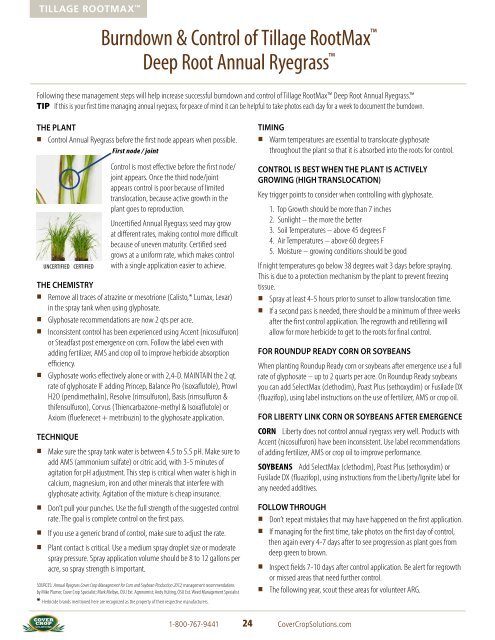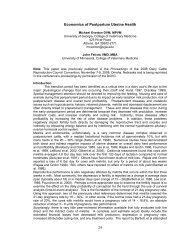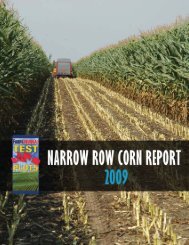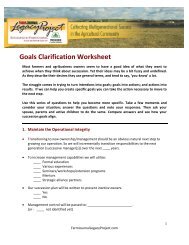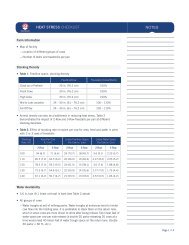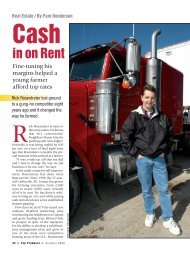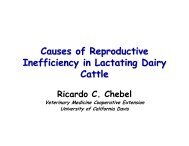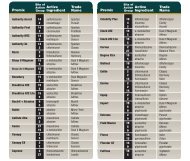Tillage Radish® Resource Guide - Cover Crop Solutions
Tillage Radish® Resource Guide - Cover Crop Solutions
Tillage Radish® Resource Guide - Cover Crop Solutions
Create successful ePaper yourself
Turn your PDF publications into a flip-book with our unique Google optimized e-Paper software.
Burndown & Control of <strong>Tillage</strong> RootMax Deep Root Annual Ryegrass Following these management steps will help increase successful burndown and control of <strong>Tillage</strong> RootMax Deep Root Annual Ryegrass.TIP If this is your first time managing annual ryegrass, for peace of mind it can be helpful to take photos each day for a week to document the burndown.TILLAGE ROOTMAX THE PLANT• Control Annual Ryegrass before the first node appears when possible.First node / jointControl is most effective before the first node/joint appears. Once the third node/jointappears control is poor because of limitedtranslocation, because active growth in theplant goes to reproduction.Uncertified Annual Ryegrass seed may growat different rates, making control more difficultbecause of uneven maturity. Certified seedgrows at a uniform rate, which makes controlUNCERTIFIED CERTIFIED with a single application easier to achieve.THE CHEMISTRY• Remove all traces of atrazine or mesotrione (Calisto,* Lumax, Lexar)in the spray tank when using glyphosate.• Glyphosate recommendations are now 2 qts per acre.• Inconsistent control has been experienced using Accent (nicosulfuron)or Steadfast post emergence on corn. Follow the label even withadding fertilizer, AMS and crop oil to improve herbicide absorptionefficiency.• Glyphosate works effectively alone or with 2,4-D. MAINTAIN the 2 qt.rate of glyphosate IF adding Princep, Balance Pro (isoxaflutole), ProwlH2O (pendimethalin), Resolve (rimsulfuron), Basis (rimsulfuron &thifensulfuron), Corvus (Thiencarbazone-methyl & Isoxaflutole) orAxiom (fluefenecet + metribuzin) to the glyphosate application.TECHNIQUE• Make sure the spray tank water is between 4.5 to 5.5 pH. Make sure toadd AMS (ammonium sulfate) or citric acid, with 3-5 minutes ofagitation for pH adjustment. This step is critical when water is high incalcium, magnesium, iron and other minerals that interfere withglyphosate activity. Agitation of the mixture is cheap insurance.• Don’t pull your punches. Use the full strength of the suggested controlrate. The goal is complete control on the first pass.• If you use a generic brand of control, make sure to adjust the rate.• Plant contact is critical. Use a medium spray droplet size or moderatespray pressure. Spray application volume should be 8 to 12 gallons peracre, so spray strength is important.SOURCES: Annual Ryegrass <strong>Cover</strong> <strong>Crop</strong> Management for Corn and Soybean Production 2012; management recommendationsby Mike Plumer, <strong>Cover</strong> <strong>Crop</strong> Specialist; Mark Melbye, OSU Ext. Agronomist; Andy Hulting, OSU Ext. Weed Management Specialist* Herbicide brands mentioned here are recognized as the property of their respective manufacturers.1-800-767-9441 <strong>Cover</strong><strong>Crop</strong><strong>Solutions</strong>.comTIMING• Warm temperatures are essential to translocate glyphosatethroughout the plant so that it is absorbed into the roots for control.CONTROL IS BEST WHEN THE PLANT IS ACTIVELYGROWING (HIGH TRANSLOCATION)Key trigger points to consider when controlling with glyphosate.1. Top Growth should be more than 7 inches2. Sunlight – the more the better3. Soil Temperatures – above 45 degrees F4. Air Temperatures – above 60 degrees F5. Moisture – growing conditions should be goodIf night temperatures go below 38 degrees wait 3 days before spraying.This is due to a protection mechanism by the plant to prevent freezingtissue.• Spray at least 4-5 hours prior to sunset to allow translocation time.• If a second pass is needed, there should be a minimum of three weeksafter the first control application. The regrowth and retillering willallow for more herbicide to get to the roots for final control.FOR ROUNDUP READY CORN OR SOYBEANSWhen planting Roundup Ready corn or soybeans after emergence use a fullrate of glyphosate – up to 2 quarts per acre. On Roundup Ready soybeansyou can add SelectMax (clethodim), Poast Plus (sethoxydim) or Fusilade DX(fluazifop), using label instructions on the use of fertilizer, AMS or crop oil.For LIBERTY LINK corn or soybeans after emergenceCORN Liberty does not control annual ryegrass very well. Products withAccent (nicosulfuron) have been inconsistent. Use label recommendationsof adding fertilizer, AMS or crop oil to improve performance.SOYBEANS Add SelectMax (clethodim), Poast Plus (sethoxydim) orFusilade DX (fluazifop), using instructions from the Liberty/Ignite label forany needed additives.FOLLOW THROUGH• Don’t repeat mistakes that may have happened on the first application.• If managing for the first time, take photos on the first day of control,then again every 4-7 days after to see progression as plant goes fromdeep green to brown.• Inspect fields 7-10 days after control application. Be alert for regrowthor missed areas that need further control.• The following year, scout these areas for volunteer ARG.24


